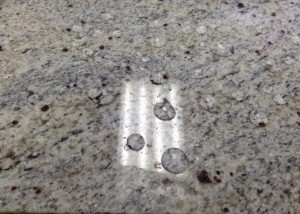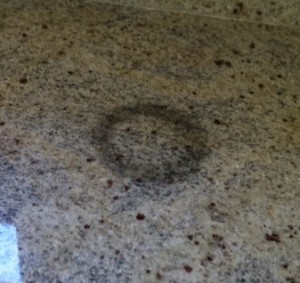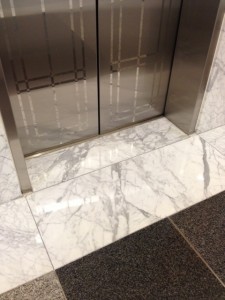A preview of our Stonexpo Presentation,
CSI (Critical Stone Investigation)
How Geology and Installation Affect Stone Restoration
Course # TU20, Tuesday, January 28, 2014
In our latest blog, “What is Natural Stone?” I mentioned that stones have their own characteristics. What I would like to do now is delve into a couple of these characteristics that are particularly important in the stone restoration field: porosity and abrasion resistance.
According to Chuck Muehlbauer, Technical Director of the Marble Institute of America, porosity is the volume of pore space within the stone fabric, generally expressed as a percentage of the total volume of the stone.
Not all stones have the same porosity. Certain stones are much more porous than other stones, meaning liquids absorb into the pores of these stones faster. Have you ever put a glass of water on a granite countertop and found that the condensation has left a dark ring? Give it about 30 minutes or so and that dark ring eventually evaporates out. This situation is a perfect example of your stone showing you its porosity.


Knowing the porosity of the stone allows you to determine the most appropriate installation and protection methods.
For example, if a stone is extremely porous, think twice before installing it as a shower floor. But let’s face it; stones and most grout lines are porous. That is why we recommend sealing with a penetrating sealer (also called an impregnating sealer). Penetrating sealers go into the pores of the stone and repel liquids like water, coffee, tea, grease, oil, etc. Penetrating sealers are not topical sealers, so they do not scuff, scratch or yellow.
Please note that calcareous stones react to acids even if you seal your natural stone.
Another natural stone characteristic that is very important in the stone restoration industry is abrasion resistance: a stone’s ability to resist wear.
Think for a moment that you are in a busy office building; if you look at the foot traffic patterns, you will most likely see the most worn areas in front of the elevator thresholds. Over time, stones in high traffic areas all need some sort of maintenance, but there is a big difference if that stone threshold is granite or marble. If it is marble, you will most likely have to maintain that surface more frequently compared to a granite elevator threshold because marble is typically a softer material. The abrasion resistance of a natural stone also helps you to determine what tools and products need to be used in order to hone or polish the surface.

This post is just a snippet of information that we will be discussing at our Stonexpo course # TU20, “CSI (Critical Stone Investigation): How Geology and Installation Affect Stone Restoration.” Rawi Tabbah, David Bonasera and Chuck Muehlbauer will be presenting January 28, 2014 at the Mandalay Bay in Las Vegas.
